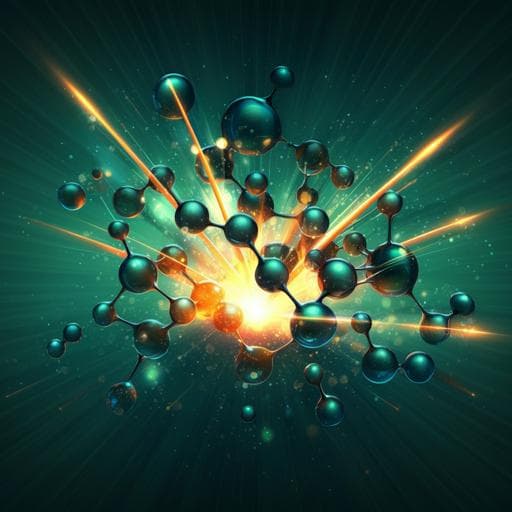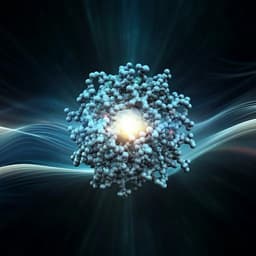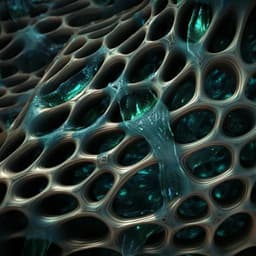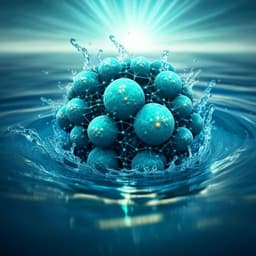
Engineering and Technology
Highly efficient and robust noble-metal free bifunctional water electrolysis catalyst achieved via complementary charge transfer
N. K. Oh, J. Seo, et al.
Discover an innovative bifunctional water electrolysis catalyst combining perovskite oxides and potassium ion-bonded MoSe₂ that outperforms traditional catalysts. This breakthrough, led by researchers Nam Khen Oh and colleagues, achieves impressive stability and efficiency in hydrogen and oxygen evolution reactions, withstanding over 2,500 hours of demanding conditions.
~3 min • Beginner • English
Introduction
Hydrogen is a clean, high energy density fuel, and electrocatalytic water splitting is a key route for sustainable H2 production. State-of-the-art noble-metal catalysts (Pt/Pd for HER and RuO2/IrO2 for OER) achieve high performance but suffer from scarcity, cost, and poor stability in alkaline systems. Bifunctional catalysts that operate efficiently for both HER and OER in the same electrolyte can simplify systems, yet overall water electrolysis rates are often limited by sluggish OER kinetics (multi-proton-coupled electron transfers and breaking of the O–O double bond). Heterostructured catalysts have been explored to tune electronic structure via morphology, composition, and doping, typically relying on unidirectional charge transfer between components. Such an approach may limit optimal electronic tuning for both half-reactions. In addition, stability at industrially relevant high current densities remains challenging due to degradation (e.g., Ostwald ripening, aggregation, detachment). This study introduces a heterostructured bifunctional catalyst composed of a perovskite oxide (La0.5Sr0.5CoO3−δ, LSC) and potassium-ion-bonded MoSe2 (K-MoSe2), leveraging complementary (multidirectional) charge transfer from both K and LSC into MoSe2 to modulate electronic structure. The design aims to enhance HER via increased metallic 1T-MoSe2 content and conductivity, and boost OER via increased electrophilicity of LSC and improved adsorption of oxygen intermediates, thereby maximizing overall water electrolysis efficiency and durability at high current densities.
Literature Review
Prior work has established noble-metal catalysts (Pt/Pd for HER; RuO2/IrO2 for OER) as benchmarks for water electrolysis but with drawbacks in alkaline media (stability, scarcity). Heterostructured catalysts combining transition metals (Co, Ni, Fe, Cu) or noble-metal composites (Pt, Ag, Pd, Au, Rh) have been explored to control morphology, composition, and doping, with charge transfer identified as a key lever for modulating electronic structure and Faradaic efficiency. However, most heterostructures have employed unidirectional charge transfer, potentially limiting simultaneous optimization of HER and OER. Earlier related work combined perovskite oxides with transition-metal dichalcogenides (TMDs) to induce in-situ local phase transitions in TMDs. Additionally, many bifunctional catalysts demonstrate stability only at relatively low current densities, with degradation mechanisms (Ostwald ripening, aggregation, detachment) limiting durability. These gaps motivate the present complementary charge-transfer strategy within an LSC/K-MoSe2 heterostructure to simultaneously tune both HER and OER activities and achieve robust stability at high current densities.
Methodology
Synthesis: K-MoSe2 was prepared by molten-metal-assisted intercalation: 500 mg bulk MoSe2 and 200 mg potassium metal were sealed under inert conditions and heated at 400 °C for 1 h, followed by rinsing (DI water, ethanol) and drying (80 °C, 24 h). LSC perovskite was synthesized by a sol–gel route: aqueous La(NO3)3·6H2O, Sr(NO3)2, Co(NO3)2·6H2O with citric acid, solvent evaporation to a wet gel, calcination at 900 °C for 2 h and 950 °C for 10 h, then mortaring. The LSC/K-MoSe2 heterostructure was formed by high-energy ball milling LSC and K-MoSe2 with 10 wt.% Ketjen Black (KB) in ethanol (planetary mill, 500 rpm, 2 h). Mixture ratios (LSC:K-MoSe2:KB) of 8:1:1, 7:2:1, 6:3:1, and 5:4:1 were screened; the optimal was 5:4:1.
Characterization: Morphology and elemental mapping via HR-TEM/HAADF-STEM/EDS; crystal structure by XRD; chemical states and work function by XPS/UPS; surface adsorption capacity by TGA (to 600 °C, 10 °C min−1); surface area and porosity by N2 adsorption–desorption (BET, BJH); optical properties by UV–Vis–NIR; Raman spectroscopy; SEM before/after stability tests.
Electrochemistry: Half-cell HER and OER in N2-saturated 1 M KOH using three-electrode setup (Ag/AgCl reference, carbon rod counter) on glassy carbon (0.071 cm2) with drop-cast catalyst inks (9 mg catalyst + 1 mg KB in Nafion/ethanol/IPA; Pt/C and IrO2 inks without KB). LSV at 5 mV s−1: HER 0 to −1.0 V vs RHE; OER 1.0 to 2.0 V vs RHE. Tafel slopes from 1–10 mA cm−2 region. EIS at −0.2 V (HER) and 0.7 V (OER) vs RHE, 100 kHz–0.01 Hz, 10 mV amplitude. iR correction applied using R_u from EIS. Double-layer capacitance from cyclic voltammetry in non-Faradaic region (0.03–0.33 V vs RHE) at 20–160 mV s−1. Overall water electrolysis in two-electrode cells on Ni foam (1 mg cm−2 loading) using LSC/K-MoSe2 for both electrodes or Pt/C||IrO2 references; LSV and chronopotentiometry at target current densities. Stability tested at 100 mA cm−2 in 1 M KOH at room temperature, and under harsh conditions (1 M KOH at 60 °C up to 1000 mA cm−2; 10 M KOH at room temperature).
Computations: Spin-polarized DFT (VASP, PAW, PBE, DFT+U with Ueff(Co-3d)=3.3 eV, Ueff(Mo-4d)=4.0 eV). LSC slab (2√2×3√2×2) with >20 Å vacuum; 1×1×1 k-mesh; 400 eV cutoff. Heterostructures modeled with MoSe2 monolayers (2×5 supercells) on LSC(001); K atoms at most stable adsorption site. Bader analysis for charge transfer. HER free energy GH = EH + 0.24 eV; OER free energies ΔG = ΔE + ΔZPE − TΔS at pH 7, 298 K, 0 V vs RHE; lattice-oxygen participation mechanism considered. DOS analyses supported charge transfer and intermediate stability.
Key Findings
- Optimal composition: LSC/K-MoSe2 weight ratio 5:4 delivered the best catalytic performance.
- HER (1 M KOH, three-electrode): LSC/K-MoSe2 overpotential 128 mV at 10 mA cm−2 with Tafel slope 45 mV dec−1; K-MoSe2 and LSC required 288 and 450 mV with Tafel slopes 62 and 119 mV dec−1, respectively; Pt/C achieved 68 mV and 31 mV dec−1. EIS Rct for HER: LSC/K-MoSe2 1.30 Ω cm2 vs K-MoSe2 2.56 and LSC 5.78 Ω cm2.
- OER (1 M KOH): LSC/K-MoSe2 overpotential 230 mV at 10 mA cm−2 with Tafel slope 79 mV dec−1, outperforming IrO2 (350 mV, 81 mV dec−1). LSC required 420 mV (131 mV dec−1); K-MoSe2 showed negligible OER. EIS Rct for OER: LSC/K-MoSe2 1.52 Ω cm2 vs LSC 1.91 and K-MoSe2 74.0 Ω cm2.
- Overall water electrolysis (two-electrode, 1 M KOH): LSC/K-MoSe2||LSC/K-MoSe2 cell voltages 1.59 V (10 mA cm−2) and 1.95 V (100 mA cm−2), better than Pt/C||IrO2 (1.67 V and 2.04 V). Energy efficiency at 100 mA cm−2: 75.4%.
- Durability: Continuous operation for >2,500 h at 100 mA cm−2 without performance degradation; Pt/C||IrO2 failed within ~60 h. Under harsher conditions: in 1 M KOH at 60 °C, stable over ~1,200 h at 500 mA cm−2 (2.25 V) and ~800 h at 1000 mA cm−2 (2.52 V); in 10 M KOH at RT, 1.87 V at 100 mA cm−2 with ~1,600 h stability.
- Structure and surface properties: BET surface area (m2 g−1): LSC/K-MoSe2 203.94, K-MoSe2 104.51, LSC 32.54. TGA after wet-air exposure showed ~14% weight loss for LSC/K-MoSe2 vs ~2% for components, indicating enhanced surface adsorption. Mesoporous pore sizes (2–50 nm). Raman red shifts (~2 cm−1) suggest electronic interaction. UPS work function increased to 5.38 eV (vs LSC 5.15 eV, K-MoSe2 5.22 eV). UV–Vis–NIR confirmed metallic characteristics (absence of A/B excitons).
- XPS: Co 2p peaks upshifted by ~1 eV in LSC/K-MoSe2; Co3+/Co2+ ratio increased from 1.5 (LSC) to 2.4 (heterostructure), indicating near-unity eg occupancy favorable for OER. O 1s showed increased surface-adsorbed oxygen to lattice oxygen ratio (SO/LO), beneficial for OER kinetics. MoSe2 phase composition: 1T-phase fraction ~91% in LSC/K-MoSe2 vs ~67% in K-MoSe2.
- DFT insights: Complementary charge transfer into MoSe2 totals 2.48 e (0.88 e from K, 1.60 e from LSC). Charge depletion occurs primarily in the LSC CoO2 subsurface layer. 2H→1T transition barrier reduced from 0.65 eV (MoSe2) to 0.18 eV (LSC/K-MoSe2). HER ΔG_H* minimized at 0.25 eV for LSC/K-MoSe2 (vs LSC 2.01 eV, 2H-MoSe2 1.44 eV, K-MoSe2 0.69 eV). OER free energy barriers for rate-determining steps: LSC 2.53 eV > LSC/MoSe2 2.06 eV > LSC/K-MoSe2 1.83 eV; consistent with experimental activity trends and superior to IrO2 benchmarks (reported 2.05–2.19 eV).
Discussion
The study demonstrates that complementary (multidirectional) charge transfer within the LSC/K-MoSe2 heterostructure simultaneously optimizes HER and OER kinetics. Electron donation from K and LSC increases the metallic 1T-MoSe2 fraction and conductivity, creating electron-rich active sites that lower HER barriers and approach Volmer–Tafel behavior. Concurrently, electron donation from LSC to MoSe2 renders Co in LSC more electrophilic, upshifts the d-band center, and enhances adsorption of oxygen-related intermediates (O*, OH*, OOH*), improving OER kinetics beyond IrO2. Spectroscopic signatures (UPS work function increase, XPS Co3+/Co2+ ratio rise, higher SO/LO in O 1s) and DFT (Bader charge transfer, reduced 2H→1T barrier, optimal ΔG_H*, balanced OER subreaction free energies) corroborate the mechanism. The synergistic effects translate to full-cell performance surpassing Pt/C||IrO2 in alkaline media with exceptional durability at high current densities and under harsh conditions, addressing the key limitations of noble-metal catalysts for practical water electrolysis.
Conclusion
A noble-metal-free bifunctional electrocatalyst, LSC/K-MoSe2, leveraging complementary charge transfer between perovskite oxide and alkali-treated MoSe2, achieves high HER and OER activity and unprecedented durability for alkaline overall water electrolysis. The heterostructure exhibits low overpotentials, favorable Tafel slopes, reduced interfacial resistances, and full-cell voltages superior to Pt/C||IrO2, with >2,500 h stability at 100 mA cm−2 and strong performance under demanding conditions. Electronic-structure modulation—higher metallic 1T-MoSe2 content and tuned Co eg occupancy with increased electrophilicity—underpins the performance gains. The concept provides a promising pathway toward replacing precious-metal-based electrocatalysts in industrial water electrolysis.
Limitations
The study focuses on alkaline electrolytes (primarily 1 M KOH, with additional tests in 10 M KOH) and does not report performance in acidic media. While overall performance surpasses Pt/C||IrO2 in full-cell operation, the HER half-cell activity remains slightly lower than Pt/C. Explicit limitations are not extensively discussed beyond these contexts.
Related Publications
Explore these studies to deepen your understanding of the subject.







